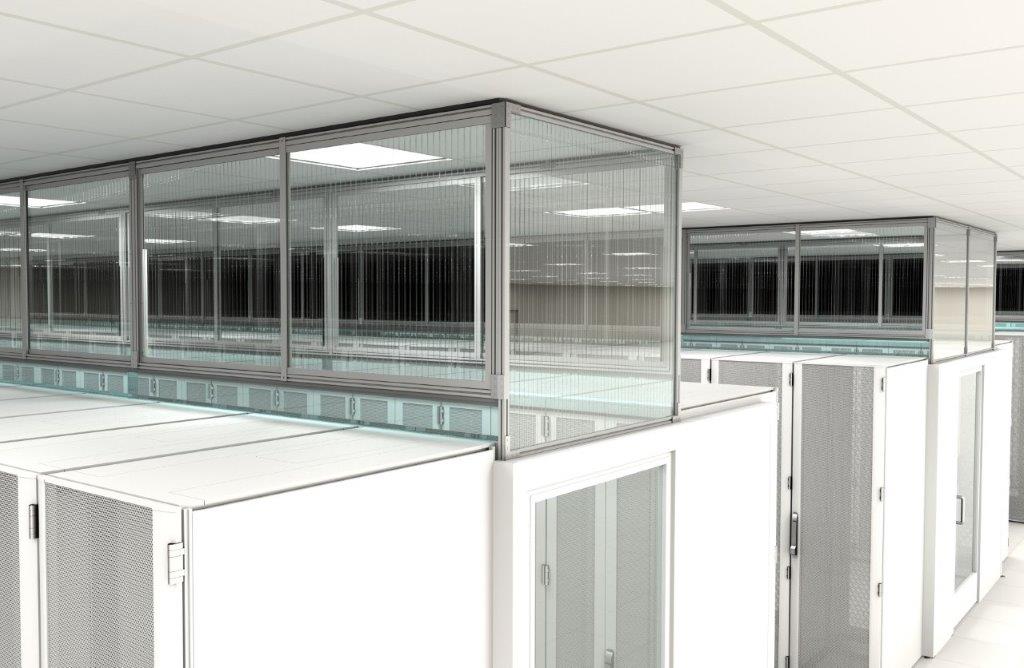Aisle Containment Systems
Build-to-suit aisle containment solutions.
Cool Shield™ containment is built-to-suit. Our containment solutions are customizable to fit data centers of any size.
What is Aisle Containment?
Aisle containment is a cooling system that completely separates the cold supply airflow from the hot equipment exhaust air.
Aisle containment creates an even and consistent supply intake temperature for data center equipment and electronics. The returning air is warmer and drier when it reaches the AC coil.
Why is Aisle Containment so Important?
Aisle containment is an important environmental control standard in the data center industry because it removes the risk of servers and other sensitive electronics from overheating, which in turn saves companies upwards of thousands of dollars in energy costs a year. With a proper containment system in place the data center manager’s ability to fully separate cold airflow from exhaust air coming from hot equipment is an option that can be monitored precisely. The result is a supply temperature that is uniform and predictable.
There can be either hot or cold containment implemented, depending on your particular facility’s layout.
Active data centers run extremely hot. The worst enemy of a data center is a non-monitored, poorly designed system without a sufficient cooling system in place. Servers have their own internal cooling mechanisms, but the hot air from the surrounding environment still makes its way into the server intakes. The result is overheating, which results in reduced server performance and/or equipment damage due to excessive heat. Aisle containment plays a critical role in ensuring consistent temperature control.
One of the data center manager’s primary responsibilities is to keep the machines operating at an ideal temperature, which is between 70° and 75° F. A lay person would suggest that a manager could simply cool the entire room. For many reasons, this is both inefficient and costly. Many data centers and server farms are extremely large structures with a plethora of air that needs constant cycling. Furthermore, the costs of managing a data center skyrockets as these facilities became larger and more complex.

HAC vs CAC
Hot Aisle vs. Cold Aisle Containment Systems

Aisle containment is a layout design for server racks and other computing equipment in a data center. The goal of a hot or cold aisle configuration is to conserve energy and lower cooling costs by managing air flow.
Designing the proper containment system requires lining server racks in rows (or aisles) with the cold air intakes facing one direction and hot air exhaust facing the other. This makes one side of the row hot and the other side cold.
The system is built around a CRAC (computer room air conditioning unit). The cold air intake side of the row faces the CRAC output ducts.This is the cold aisle. The hot aisle is where the hot side of the row typically pours into the CRAC intake. Keeping these aisles separated from one another is the core of containment.
Proper aisle containment creates a physical barrier that separates the hot and cold air from mixing. Containment panels or strips create a partition to isolate either the server supply air (cold aisle) or the exhaust air (hot aisle). Preventing the supply and exhaust air from mixing significantly increases the capacity and cooling efficiency of the cooling infrastructure.
Some data centers focus on one or the other. Site conditions dictate the best approach. At most sites, it is easier to implement a cold aisle containment system because there are typically cable trays and other obstructions above the hot aisle. It is very difficult to implement a hot aisle system if there is not a return plenum.
Frequently Asked Questions
Aisle Containment FAQs
How do drop away panels work?
The process by which drop away panels work is as follows: Drop away panels are thin plastic panels which in turn have a low melting point. At 135 degrees the panels, which are framed by the Cool Shield™ channel, will start to shrink at the edges. This causes the panels to fall to the ground. They are very lightweight and pose no risk of injury. Most temperature activated fire suppressions systems activate at 150 to 175 degrees so the panels will be out of the way before a discharge. It is important to note that drop away panels are not smoke activated. We recommend checking with local fire inspectors prior to any purchase.
Do the Cool Shield™ products offer FM Global rated solutions?
Yes. FM Global products relate to a flammability standard set forth by insurance companies. Some insurance companies either require the use of FM approved materials or provide a discount if they are used. It is a rather stringent standard and the Cool Shield™ solid and drop away panels are available with the FM 4910 rating.
Are there Cool Shield™ products that have solutions which meet NFPA 75 requirements?
Yes. Cool Shield™ strip and panel solutions are available that comply with the NFPA 75 standards.
What is NFPA 75?
NFPA 75 is the Standard for the Fire Protection of Information Technology Equipment. It is the National Fire Protection Association’s first standard which specifically provides guidelines for aisle containment. It recommends the type of materials which should be used and the proper methods for removing obstructions if there is a smoke or fire event. It is important to remember that these are standards only and the final approval of any design or installation is at the discretion of the local fire inspector.
Can I use fusible links to prevent my strips or panels from obstructing fire suppression?
Yes. Standard fusible links are the least complicated and most cost effective option for removing obstructions at a specified temperature. However, some fire marshals have concerns about the operability of standard fusible links because they are temperature activated only and do nothing if there is smoke. NFPA 75 does not support the use of standard fusible links however, some customers still choose to use them. We recommend you discuss the use of fusible links with your local fire marshal before making a purchase.
What are fusible links?
Fusible links are typically composed of two pieces of metal held together by a chemical compound. At a specified temperature the compound will lose adhesion causing the two pieces of metal to separate. The standard fusible links that we use are UL rated to separate at 135 degrees. Electronic links work the same way but are heated to the release point by an electrical wire instead of the ambient air. They can be wired to the fire control panel or other relay.
How will aisle containment affect my fire suppression system?
Unless there are both smoke and fire sensors inside and outside the isolated area, the containment will create an obstruction for both water and gas based suppression systems. Our Project Managers can assist you in determining a plan to overcome this issue. We recommend that all customers discuss their containment plans and design with their local fire marshal prior to purchase.
Can I attach the containment system to my drop ceiling grid?
Which is better, hot aisle containment or cold aisle containment?
The short answer is that both HAC and CAC are nearly equally effective because they prevent supply and exhaust air from mixing. Cold aisle containment (CAC) provides excellent control over supply temperatures to optimize CRAC set points. Hot aisle containment (HAC) returns warmer air to CRAC units which can increase cooling capacity. The best approach for your data center will be dictated by your site conditions. At most existing sites, it is easier to implement a CAC solution because there are typically cable trays and other obstructions above the hot aisle. It is also very difficult to implement hot aisle containment if there is not a return plenum. Our Project Managers can help you determine which approach would be most effective in your data center.
How much money will I save by implementing aisle containtment?
If properly installed, a data center generally can obtain 20-50% reduction in cooling costs. However, each site will be different due to the site conditions, cooling infrastructure, rack density and other factors. Efficiency is optimized if the cooling systems have variable speed fans and there is a good return air path.

